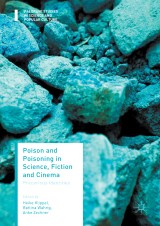Details

Poison and Poisoning in Science, Fiction and Cinema
Precarious IdentitiesPalgrave Studies in Science and Popular Culture
|
85,59 € |
|
| Verlag: | Palgrave Macmillan |
| Format: | |
| Veröffentl.: | 14.11.2017 |
| ISBN/EAN: | 9783319649092 |
| Sprache: | englisch |
Dieses eBook enthält ein Wasserzeichen.
Beschreibungen
<p>This book is about poison and poisonings; it explores the facts, fears and fictions that surround this fascinating topic. Poisons attract attention because they are both dangerous and hard to discover. Secretive and invisible, they are a challenging object of representation. How do science studies, literature, and especially film—the medium of the visible—explain and show what is hidden? How can we deal with uncertainties emerging from the ambivalence of dangerous substances? These considerations lead the editors of this volume to the notion of “precarious identities” as a key discursive marker of poisons and related substances. This book is unique in facilitating a multi-faceted conversation between disciplines. It draws on examples from historical cases of poisoning; figurations of uncertainty and blurred boundaries in literature; and cinematic examples, from early cinema and arthouse to documentary and blockbuster. The contributions work with concepts from gender studies, new materialism, post-colonialism, deconstructivism, motif studies, and discourse analysis.</p><p></p><p> </p><p> </p>
<div>1.Introduction - Heike Klippel, Bettina Wahrig, Anke Zechner.- 2. Cases and Environments: Female Poisoners in Eighteenth-Century Germany - Julia Saatz.- 3. The Truth About the Lafarge Affair: Controversies and Poisons in Salons and Academies - José Bertomeu Sanchez.- 4. “Nature is Lopsided”: Muscarine as Scientific and Literary Fascinosum - Bettina Wahrig.- 5. “Everything stays down where it’s wounded”: Precarious Ontologies and Ecologies of Poison - Stephan Trinkaus.- 6. Metamorphoses: “Life and death appeared to me ideal bounds”: Investigations into Life, Death, Resuscitation and “Vegetable Poisons” in Early Nineteenth-Century Britain - Silvia Micheletti.- 7. “These Pale Alchemies”: Lucretia Borgia in Nineteenth-Century Literature - Martina Mittag.- 8. Magic Matters: On Sexed Bodies and Early Film - Kathrin Peters.- 9. Fun and Games: The Joy of Poisoning in Children’s Literature - Sylvia A. Pamboukian.- 10. Nuclear Power Subjects: Superheroes and Energetic Film - André Wendler.-11. Visualizing the Invisible: From Substance to Phantasm. Poison Motifs in Narrative Cinema Heike Klippel.- 12. Cinema and the Motif of Poison as Intermingling - Anke Zechner.- 13. Serial Poisoning: Actualizations of the “Yellow Peril” in 1960s Fu Manchu Films - Maja Figge.- 14. Poison Ivy, Lux Interior, Cramps: Cinema as Ontoxicological “Mit-Gift” (Being-With Not as a Given) - Drehli Robnik.- 15. Queering Autoimmunity with Sexual Difference: On Todd Haynes’ Poison (1991) and Safe (1997) - Astrid Deuber-Mankowsky.- 16. Conclusion: Identity, Precariousness, and Poison: A Brief and Political Outlook - Heiko Stoff. </div><div><br/></div>
<p><b>Heike Klippel</b> is Professor of Film Studies at the Braunschweig University of Art, Germany. <br/><b><br/>Anke Zechner</b> was a research fellow on the DFG project “The Poison Motif in Film” and is currently working on a research project on Poisonous Cinema.<br/><br/><b>Bettina Wahrig</b> is Professor of the History of Science and Pharmacy at Braunschweig University of Technology, Germany. <br/></p><p></p>
This book is about poison and poisonings; it explores the facts, fears and fictions that surround this fascinating topic. Poisons attract attention because they are both dangerous and hard to discover. Secretive and invisible, they are a challenging object of representation. How do science studies, literature, and especially film—the medium of the visible—explain and show what is hidden? How can we deal with uncertainties emerging from the ambivalence of dangerous substances? These considerations lead the editors of this volume to the notion of “precarious identities” as a key discursive marker of poisons and related substances. This book is unique in facilitating a multi-faceted conversation between disciplines. It draws on examples from historical cases of poisoning; figurations of uncertainty and blurred boundaries in literature; and cinematic examples, from early cinema and arthouse to documentary and blockbuster. The contributions work with concepts from gender studies, new materialism, post-colonialism, deconstructivism, motif studies, and discourse analysis. <p> </p>
Examines poisons and related substances in a transdisciplinary context, comprising the history of science, literature and film studies Conceptualizes poison as “precarious”. This innovative perspective highlights poison as a medium of undermining identity and society and takes poison as a metaphor for social instability The contributions in the volume cover a wide range from prominent court cases, including the Lafarge affair, to scientific disputes, literary analyses and cutting-edge theory Includes supplementary material: sn.pub/extras
<p>Examines poisons and related substances in a transdisciplinary context, comprising the history of science, literature and film studies</p> <p>Conceptualizes poison as “precarious”. This innovative perspective highlights poison as a medium of undermining identity and society and takes poison as a metaphor for social instability</p> <p>The contributions in the volume cover a wide range from prominent court cases, including the Lafarge affair, to scientific disputes, literary analyses and cutting-edge theory</p> <br/><p></p>
“With the recent advances in genetics and forensic science, this book placing poisoning in historical and cultural context makes a welcome contribution. Through careful analyses, the contributors to this volume examine the ways that fiction-writers and film-makers have used poisons to structure their artistic works. Their studies bring together literary analysis and the history of science to reveal the cultural uses of ‘precarious substances’ that destabilize complex organisms.” (Laura Otis, Historian of Science and Professor of English, Emory University, USA) <p>“This is a much needed book in times of toxic media-ecologies. With much elegance, the essays unfold the rich history of precarious objects and subjects we all seem to have become.” (Karin Harrasser, Professor for Cultural Theory, University of Art and Design Linz, Austria)</p>

















